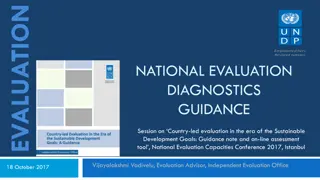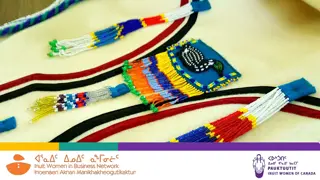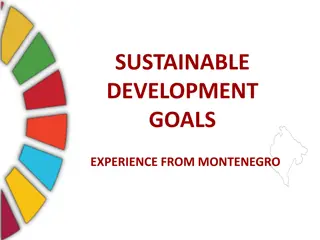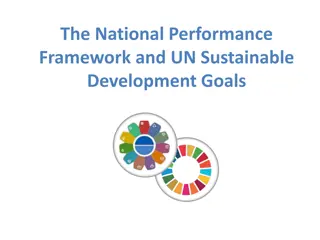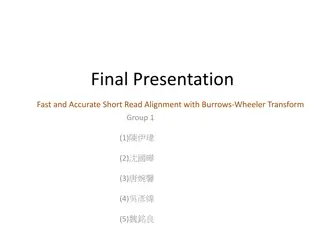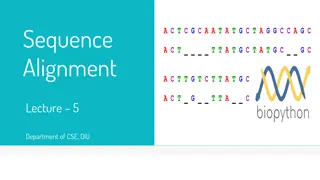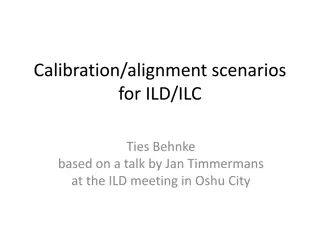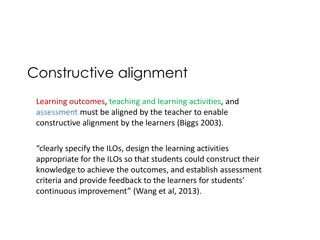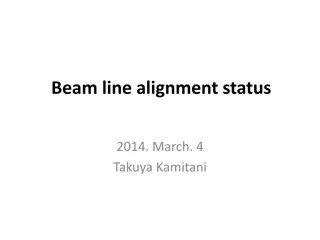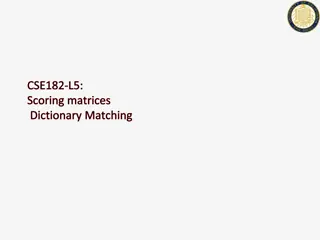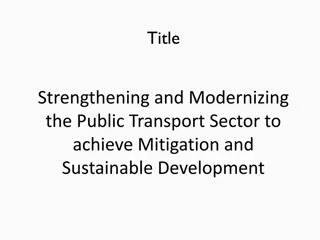Sustainable Development Goals: Progress and Alignment with National Development Strategies
The presentation outlines the transition from Millennium Development Goals (MDGs) to Sustainable Development Goals (SDGs), highlighting achievements and challenges faced. It discusses the alignment of SDGs and Agenda 2063 with national development strategies, focusing on areas such as agricultural development and poverty eradication. The process of localizing SDGs through domestication into multiple languages is also illustrated.
Download Presentation

Please find below an Image/Link to download the presentation.
The content on the website is provided AS IS for your information and personal use only. It may not be sold, licensed, or shared on other websites without obtaining consent from the author.If you encounter any issues during the download, it is possible that the publisher has removed the file from their server.
You are allowed to download the files provided on this website for personal or commercial use, subject to the condition that they are used lawfully. All files are the property of their respective owners.
The content on the website is provided AS IS for your information and personal use only. It may not be sold, licensed, or shared on other websites without obtaining consent from the author.
E N D
Presentation Transcript
1 SDGs Indicator Framework, Data and Evaluation : National Follow-up and Review Processes By : Phindile Masango 18thOctober, 2017
2 PRESENTATION OUTLINE The MDG era The Sustainable Development Goals Agenda The Localisation process
3 Millennium Development Goals Era The Millennium Development Goals (MDGs) process 2000 millennium declaration (15 years) 8 goals, 18 targets and 48 indicators Five reports were produced in the country during the MDGs era, 2003, 2007, 2010, 2012 and 2015 The country achieved five out of the eight goals namely MDGs 2, 3, 6, 7 and 8 Challenge was faced in three goals namely MDGs 1, 4 and 5
4 Sustainable Development Goals SDGs were launched in June 2016 by the Honourable Minister for Economic Planning and Development. The technical working group was established SDG Baseline Report on global indicators was drafted in 2016.
5 Global Baseline report 2016 at a glace 90 86 80 68 70 60 56 55 53 50 50 50 45 42 40 36 36 33 30 29 27 30 24 20 11 10 0 SDG 1 SDG 2 SDG 3 SDG 4 SDG 5 SDG 6 SDG 7 SDG 8 SDG 9 SDG 10 SDG 11 SDG 12 SDG 13 SDG 14 SDG 15 SDG 16 SDG 17
ALIGNMENT OF SDGs AND AGENDA 2063 WITH NDS 6 MACRO STRATEGIC AREA 1. Agricultural Development MINISTRIES/SECTORS Agriculture, Natural Resources and Energy, Commerce Industry and Trade, Tourism and Environmental Affairs, AGENDA 2063 Goals -A high standard of living , quality of life and wellbeing for all citizens SDGs -End poverty in all its forms everywhere. -End hunger, achieve food security and improved nutrition and promote sustainable agriculture. - Modern agriculture for increased productivity and production -Ensure sustainable consumption and production patterns -Take urgent action to combat climate change and its impacts. -Protect restore and promote sustainable use of terrestrial ecosystems, sustainably manage forests, combat desertification and halt and reverse land degradation and halt biodiversity loss.
7 SDGs Domestication English 1. End poverty in all its forms everywhere SiSwati 1. Kucedza lonkhe luhlobo lwebuphuya nebusweti eveni 2. Kucedza indlala, kucinisekisa kutsi sonkhe sive sinekudla lokwanele lokunemaseko ladzingekile ngekundlondlobalisa tekulima letikhonsako 2. End hunger, achieve food security and improved nutrition and promote sustainable agriculture 3. Kucinisekisa simo semphilo lesikahle kubobonkhe bantfu eveni. 3. Ensure healthy lives and promote well-being for all at all ages 4. Kucinisekisa ematfuba emfundvo lesecophelweni lelisetulu nalechubekako eveni ngalokulinganako 4. Ensure inclusive and equitable quality education and promote lifelong learning opportunities for all
8 SDGs Prioritisation Process PRIORITIZED GOAL 8. Decent work and economic growth CROSS CUTTING 5. Gender equality ENABLERS 15. Life on land 4. Quality education 1. No poverty 16. Peace justice and strong institutions 17. Partnership for the goals 3. Good health and well-being 12. Responsible consumption and production 11. Sustainable cities and communities 7. Affordable and clean energy 10. Reduced inequalities 9. Industry innovation and infrastructure 2. Zero hunger 6. Clean water and sanitation 13. Climate action 14. Life below water
9 SDGs Localisation Localizing is the process of taking into account subnational contexts of developmet in the achievement of the 2030 Agenda, from the setting of goals and targets, to determining the means of implementation and using indicators to measure and monitor progress. Activity was undertaken with the assistance of the SDGs Technical working team.
SDGs Localisation Process 10 Goal 1. End poverty in all its forms everywhere Target 1.1 By 2030, eradicate extreme poverty for all everywhere, currently measured as people living on less than $1.25 a day Indicator 1.1.1 below the international poverty line, by sex, age, employment status and geographical (urban/rural) Proposed indicator Proportion of population people Accepted location 1.2 By 2030, reduce at least by half the proportion women and children of all ages living in poverty dimensions according to national definitions 1.2.1 Proportion of population living below the national poverty line, by sex and age Accepted with further of men, disaggregation on geographic in all its location
11 SDGs Localisation Process Goal 3. Ensure healthy lives and promote well-being for all at all ages Target Indicator Proposed indicator 3.a Strengthen the 3.a.1 Age-standardized prevalence 3.a.1 Percentage of people aged implementation of the World of current tobacco use among 15-49 who smoked a whole Health Organization Framework persons aged 15 years and older cigarette before the age of 15 Convention on Tobacco Control in all countries, as appropriate 3.a.2 Percentage of people aged 15-49 who smoke cigarette or smokeless tobacco at any time during the last one month.
12 SDGs Localisation Process Goal 17. Strengthen the means of implementation and revitalize the Global Partnership for Sustainable Development Target Indicator Proposed Indicator 17.16 Enhance the Global Partnership 17.16.1 Number of countries 17.16.1 Number of reports produced for Sustainable Development, reporting progress in multi- on implementation of the SDGs complemented by multi-stakeholder stakeholder development partnerships that mobilize and share effectiveness monitoring knowledge, expertise, technology and frameworks that support the financial resources, to support the achievement of the sustainable achievement of the Sustainable development goals Development Goals in all countries, in particular developing countries
13 SDGs Baseline on localised indicators 100 96 93 93 92 90 88 86 85 81 79 80 77 74 71 71 69 70 60 60 57 50 40 40 30 20 10 0 1 2 3 4 5 6 7 8 9 10 11 12 13 14 15 16 17
14 Awareness creation Chiefdoms are different communities in the rural area overseen by the Chiefs responsible for developing chiefdom development plans. Constituencies are formed by representatives of all chiefdoms under that constituency and are led by the constituency development team also responsible for developing medium term development plans. Region is formed by a group of constituencies under that particular region it is under the auspices of the Regional Development Team. Develop regional development plan by consolidating constituency development plan
SDG 1: End poverty in all its forms everywhere Umgomo 1: Cedza luhlobo lonkhe lwebuphuya kutotonkhe tingoni
16 Awareness creation Regional dialogues were conducted in all the regions of the country with constituency and regional development teams. Purpose to create awareness on SDGs and ensure development initiatives in chiefdom, constituency and regional development plans are aligned to the prioritised SDGs.
17 Automated National Monitoring & Evaluation System The national system that will monitor the National Development Strategy, Sustainable Development Goals, Agenda 2063 and RISDP indicators is underdevelopment. It will be web based linking the Ministry of Economic Planning and Development with the different sectors. Economists in the various line Ministries will be responsible for updating SDGs indicators. The system will enable ease of data collection and report consolidation.
18 Main Objectives of the M&E System To ensure availability and use of accurate, timely, and relevant data to monitor and evaluate the National development programmes and to informed policy decision. To promote creation of M&E partnership and linkages between sectors, partners and stakeholders at various levels to enable information sharing, dissemination and use of data in planning interventions and reprogramming. To promote management performance through evidence-based planning, policy making, budgeting and development interventions implementation
19 Way forward Revive the Sector wide approach through the SDGs lens. - Sectors will be strengthened to produce sector development action plans and report implementation.
20 Tershekqu-ederem




